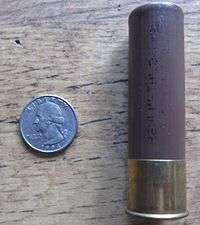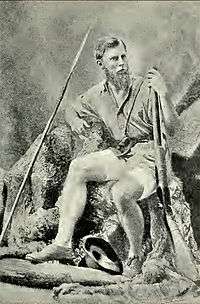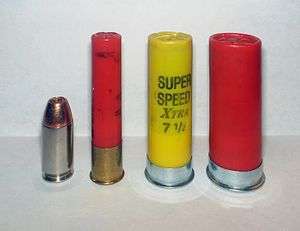Gauge (bore diameter)
| Gauge | |
|---|---|
|
| |
| Type | Shotgun |
| Place of origin | Various |
The gauge of a firearm is a unit of measurement used to express the diameter of the barrel. Gauge is determined from the weight of a solid sphere of lead that will fit the bore of the firearm, and is expressed as the multiplicative inverse of the sphere's weight as a fraction of a pound, e.g., a one-twelfth pound ball fits a 12-gauge bore. Thus there are twelve 12-gauge balls per pound, etc. The term is related to the measurement of cannon, which were also measured by the weight of their iron round shot; an 8 pounder would fire an 8 lb (3.6 kg) ball.
Gauge is commonly used today in reference to shotguns, though historically it was also used in large double rifles, which were made in sizes up to 2 bore during their heyday in the 1880s, being originally loaded with black powder cartridges. These very large rifles, sometimes called elephant guns, were intended for use in India and Africa for hunting dangerous game.
Gauge is abbreviated "ga.", "ga", or "G". The space between the number and the abbreviation is often left out, as in "12ga".
Calculating gauge
An n-gauge diameter means that a ball of lead (density 11.352 g/cm3 or 6.562 oz/in3) with that diameter has a mass equal to 1/n part of the mass of the international avoirdupois pound (453.59237 grams). Therefore, an n-gauge shotgun or n-bore rifle has a bore diameter (in inches) of approximately
Explanation: 453.59 (the number of grams in 1lb) is divided by n to find the mass of each hypothetical pure-lead ball. It is then multiplied by 3 and divided by 4 and pi (which is a rearranged volume-of-a-sphere equation) to find the volume when the density is 1g/ml. The density of lead, however, is 11.34g/ml, so the equation is divided by such to correct the density. So far, the described equation would find r3 in cm. To get the diameter in inches, three more steps must be taken following the order of operations. First, we take the cube root of everything to find the radius. Lastly, it is multiplied by 2 to find the diameter, then divided by 2.54 to convert centimeters to inches.
In addition, this complete equation can be simplified quite easily. The first step is to decimalize the outlying fraction and distribute the 3rd root radical to all the inner terms. In addition, instead of dividing by 11.34, it is possible to multiply by its reciprocal, remembering to include the radical, to get this equation.
After this, all of the terms can be separated, keeping in mind that 4 and pi are reciprocals. In addition, all reciprocals can be denoted x−1 instead of 1/x. Similarly, all cube roots can be denoted x1/3, which means that any cube roots of reciprocals will be x−1/3
Since everything on the right side of the equation is a number except for n−1/3, the final step is to find the power of all of the numbers (get rid of the exponents), then multiply all terms together. The final equation looks like this:
Furthermore, the third equation can be rearranged to solve for n instead of dn. Every term is taken to the power of three, and every number is divided by itself on both sides of the equation to get:
(For clarity's sake, n−1 has been expressed as 1/n.)
From here on, dn3 can be moved to the bottom of the fraction and be expressed as dn−3. Afterwards, the reciprocal of the entire equation can be taken, the powers of the numbers can be found, and the resulting numbers can be multiplied together to get:
An alternate equation (result is in cm):
Another source for a gauge size formula can be found in Shotgun shell.
It should be noted that the results of the calculations given above need not be carried out to further than one decimal place, as shotgun and rifle gauges are stated in integers. Furthermore, the density of the lead that was once used as the standard varied, since bullets and slugs are not made of chemically pure lead, but are instead made of lead alloyed with a variety of materials.
Gauges in use
Since shotguns were not originally intended to fire solid projectiles, but rather a compressible mass of shot, the actual diameter of the bore can vary. The fact that most shotgun bores are not cylindrical also causes deviations from the ideal bore diameter.
The chamber of the gun is larger, to accommodate the thickness of the shotshell walls, and a "forcing cone" in front of the chamber reduces the diameter down to the bore diameter. The forcing cone can be as short as a fraction of an inch, or as long as a few inches on some guns. At the muzzle end of the barrel, the choke can constrict the bore even further, so measuring the bore diameter of a shotgun is not a simple process, as it must be done away from either end.
Shotgun bores are commonly "overbored" or "backbored", meaning that most of the bore (from the forcing cone to the choke) is slightly larger than the value given by the formula. This is claimed to reduce felt recoil and improve patterning. The recoil reduction is due to the larger bore producing a slower acceleration of the shot, and the patterning improvements are due to the larger muzzle diameter for the same choke constriction, which results in less shot deformation. A 12-gauge shotgun, nominally 18.5 mm (0.73 in), can range from a tight 18.3 mm (0.72 in) to an extreme overbore of 20.3 mm (0.80 in). Some also claim an increased velocity with the overbored barrels, up to 15 m/s (49 ft/s), which is due to the larger swept volume of the overbored barrel. Once only found in expensive custom shotguns, overbored barrels are now becoming common in mass marketed guns. Aftermarket backboring is also commonly done to reduce the weight of the barrel, and move the center of mass backwards for a better balance. Factory overbored barrels generally are made with a larger outside diameter, and will not have this reduction in weight—though the factory barrels will be tougher, since they have a normal barrel wall thickness.
Firing slugs from overbored barrels can result in very inconsistent accuracy, as the slug may be incapable of obturating to fill the oversized bore.
Sizes in use


The most common size is 12 gauge,[1] with up to 50% of the overall shotgun market in the United States. The 20 gauge shotgun is favored by shooters uncomfortable with the weight and recoil of a 12 gauge gun, and is popular for upland game hunting. The next most popular sizes are 28 gauge and .410 bore. The considerably more powerful 10 gauge as well as the 16 gauges, while a little less common, are still readily available in the United States.
Shotguns and shells exceeding 10 gauge, such as the 8 and 4 gauge, are rather rarely manufactured and only a few manufacturers of the otherwise large market of shotgun, rifle and ammo makers across the United States still produce them. Shells are usually black powder paper cartridges as opposed to the plastic/wax cartridge and smokeless powder of today.
The 11, 15, 18, 2, and 3 gauge shells are rarest of all;[2] owners of these types of rare shotguns will usually have their ammunition custom loaded by a highly paid specialist in rare and custom bores. The 14 gauge has not been loaded in the United States since the early 1900s, although the 2-9/16 inch hull is made in France.[2] The very small 24 and 32 gauges are still produced and used in some European countries and Brazil. Punt guns and special purpose guns, such as the Russian 23 mm KS-23 (approximately 6 gauge), are rarely encountered.
Also seen in limited numbers are smoothbore firearms in calibers smaller than .410, such as .22 Long Rifle, .22 WMR, and 9 mm rimfire, designed for short range pest control.[3][4]
To further complicate matters, special shot cartridges are available for typical handgun chamberings such as 9 mm Parabellum, .45 ACP, .38 Special/.357 Magnum, .44 Special/.44 Magnum, and .45 Colt, as well as .22LR. These rounds are either crimped in or in a plastic casing, replacing the bullet. These are not generally considered "shot shells" by shotgun users, and the patterning performance is questionable, since they are fired through rifled barrels. Thompson/Center makes special pistol barrels in .38/.357, .44 and .45 Colt that have "straight rifled" chokes in them to reduce the spin of the shot column and produce better patterns, but they are still suitable only for pest control at very short ranges.
Gauge and shot type
The 10 gauge narrowly escaped obsolescence when steel and other nontoxic shot became required for waterfowl hunting, since the larger shell could hold the much larger sizes of low-density steel shot needed to reach the ranges necessary for waterfowl hunting. The move to steel shot reduced the use of 16 and 20 gauges for waterfowl hunting, and smaller 2.75" (70mm) 12 gauge shells as well. However, the advent of the 3.5 in (89 mm) 12 gauge shell, with its higher SAAMI pressure rating compared to standard 12 gauge guns, begin to approach the performance of the 10 gauge loads. Newer nontoxic shots, such as bismuth and tungsten-nickel-iron alloys, and even tungsten-polymer blends, regain much or all of the performance loss, but are much more expensive than steel or lead shot.[5] However, laboratory research indicates that tungsten alloys can actually be quite toxic internally.[6]
Sizes found in the UK
- 4 bore 4" (100mm)
- 8 bore 3¼" (83mm)
- 10 bore 2⅝" (19.7 x 67mm), 10 bore 2⅞" (19.7 x 73mm), 10 bore 3½" (19.7 x 89mm)
- 12 bore 2" (18.5 x 51mm), 12 bore 2½" (18.5 x 63mm), 12 bore 2¾" (18.5 x 70mm), 12 bore 3" (18.5 x 76mm), 12 bore 3½" (18.5 x 89mm)
- 14 bore 2½" (63mm)
- 16 bore 2½" (63mm), 16 bore 2¾" (70mm)
- 20 bore 2½" (63mm), 20 bore 2¾" (70mm), 20 bore 3" (76mm)
- 24 bore 2½" (63mm)
- 28 bore 2½" (63mm), 28 bore 2¾" (70mm)
- 32 bore 2½" (63mm)
- .410 bore 2" (10.4 x 51mm), .410 bore 2½" (10.4 x 63mm), .410 bore 3" (10.4 x 76mm)
- .360 bore 1¾" (9 x 45mm)
- 9mm (no.3 bore) rimfire [0.5"], 9mm (no.3 bore) long rimfire [1.4"]
- 7mm (no.2 bore) rimfire
- 6mm (no.1 bore) short rimfire, 6mm (no.1 bore) long rimfire
Conversion guide

A table showing the various gauge sizes with weights. The bores marked * are found in punt guns and rare weapons only. The .410 bore and 23mm caliber are exceptions; they are actual bore sizes, not gauges. If the .410 and 23mm were measured traditionally, they would be 67.62 gauge and 6.278 gauge, respectively.
| Gauge (Bore) | Diameter | Weight of unalloyed (pure) lead ball | |||
|---|---|---|---|---|---|
| (mm) | (in) | grams | ounces | grains | |
| AA* | 101.60 | 4.000 | 6225.52 | 219.6 | 96,080 |
| A½* | 76.20 | 3.000 | 2626.39 | 92.64 | 40,530 |
| 0.25* | 67.34 | 2.651 | 1814.36 | 64.000 | 28,000 |
| 0.5* | 53.45 | 2.103 | 907.18 | 32.000 | 14,000 |
| A* | 50.80 | 2.000 | 778.19 | 27.45 | 12,010 |
| 0.75* | 46.70 | 1.838 | 604.80 | 21.336 | 9328 |
| 1* | 42.42 | 1.669 | 453.59 | 16.000 | 7000 |
| B½* | 38.10 | 1.500 | 328.3 | 11.58 | 5066 |
| 1.5* | 37.05 | 1.459 | 302.39 | 10.667 | 4667 |
| 2* | 33.67 | 1.326 | 226.80 | 8.000 | 3500 |
| 3* | 29.41 | 1.158 | 151.20 | 5.333 | 2333 |
| 4* | 26.72 | 1.052 | 113.40 | 4.000 | 1750 |
| B* | 25.40 | 1.000 | 97.27 | 3.43 | 1501 |
| 5* | 24.80 | .976 | 90.72 | 3.200 | 1400 |
| 6* | 23.35 | .919 | 75.60 | 2.667 | 1166 |
| 6.278 | 23.00 | .906 | 72.26 | 2.549 | 1114 |
| 7* | 22.18 | .873 | 64.80 | 2.286 | 1000 |
| 8 | 21.21 | .835 | 56.70 | 2.000 | 875 |
| 9* | 20.39 | .803 | 50.40 | 1.778 | 778 |
| 10 | 19.69 | .775 | 45.36 | 1.600 | 700 |
| 11* | 19.07 | .751 | 41.24 | 1.454 | 636 |
| 12 | 18.53 | .729 | 37.80 | 1.333 | 583 |
| 13* | 18.04 | .710 | 34.89 | 1.231 | 538 |
| 14 | 17.60 | .693 | 32.40 | 1.143 | 500 |
| 15* | 17.21 | .677 | 30.24 | 1.067 | 467 |
| 16 | 16.83 | .663 | 28.35 | 1.000 | 438 |
| 17* | 16.50 | .650 | 26.68 | 0.941 | 412 |
| 18* | 16.19 | .637 | 25.20 | 0.889 | 389 |
| 20 | 15.63 | .615 | 22.68 | 0.800 | 350 |
| 22* | 15.13 | .596 | 20.62 | 0.728 | 319 |
| 24 | 14.70 | .579 | 18.90 | 0.667 | 292 |
| 26* | 14.31 | .564 | 17.44 | 0.615 | 269 |
| 28 | 13.97 | .550 | 16.20 | 0.571 | 250 |
| 32 | 13.36 | .526 | 14.17 | 0.500 | 219 |
| 36 | 12.85 | .506 | 12.59 | 0.444 | 194 |
| 40 | 12.40 | .488 | 11.34 | 0.400 | 175 |
| 67.62 | 10.41 | .410 | 6.71 | 0.237 | 104 |
Note: Use of this table for estimating bullet masses for historical large-bore rifles is limited, as this table assumes the use of round ball, rather than conical bullets; for example, a typical 4 bore rifle from circa 1880 used a 2,000-grain (4.57 oz) bullet, or sometimes slightly heavier, rather than using a 4-ounce round lead ball. (Round balls give progressively much worse external ballistic performance than conical bullets at ranges greater than about 75 yards.) In contrast, a 4-bore express rifle often used a 1,500-grain (3.43 oz) bullet wrapped in paper to keep lead buildup to a minimum in the barrel. In either case, assuming a 4-ounce mass for a 4-bore rifle bullet from this table would be inaccurate, although indicative.
References
- ↑ Carter, Greg Lee (2002). Guns in American Society: An Encyclopedia. Santa Barbara, Calif.; Oxford: ABC-CLIO. p. 361. ISBN 978-1-57607-268-4.
- 1 2 Frank C. Barnes (2009), Layne Simpson editor, Cartridges of the World, 12th Ed.
- ↑ Clair Rees (March 2000). "Marlin's 'Garden Gun'—Model 25MG". Guns Magazine.
- ↑ Frank C. Barnes (2003). Stan Skinner, ed. Cartridges of the World (10th ed.). Krause Publications. ISBN 0-87349-605-1.
- ↑ Randy Wakeman (2007). "Why The 10 Gauge Shotgun is Obsolete". chuckhawks.com.
- ↑ John Kalinich; et al. (2005). "Embedded weapons-grade tungsten alloy shrapnel rapidly induces metastatic high-grade rhabdomyosarcomas in F344 rats.". Environmental Health Perspectives.
